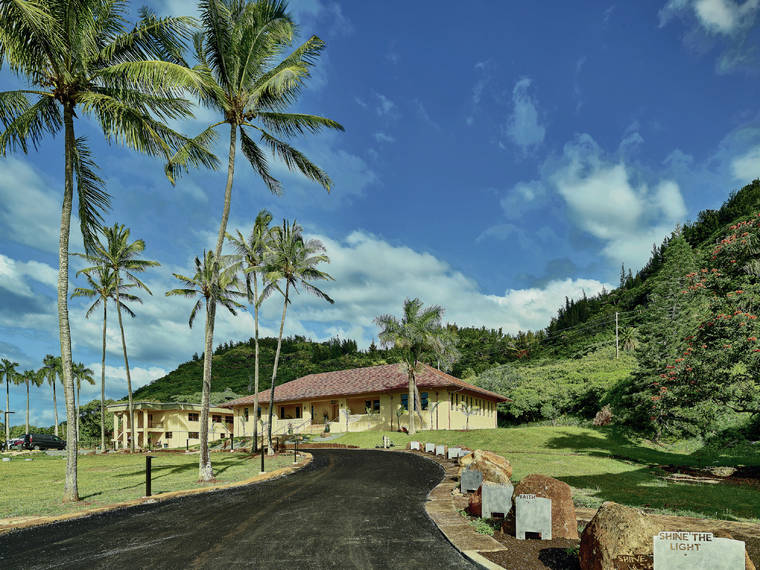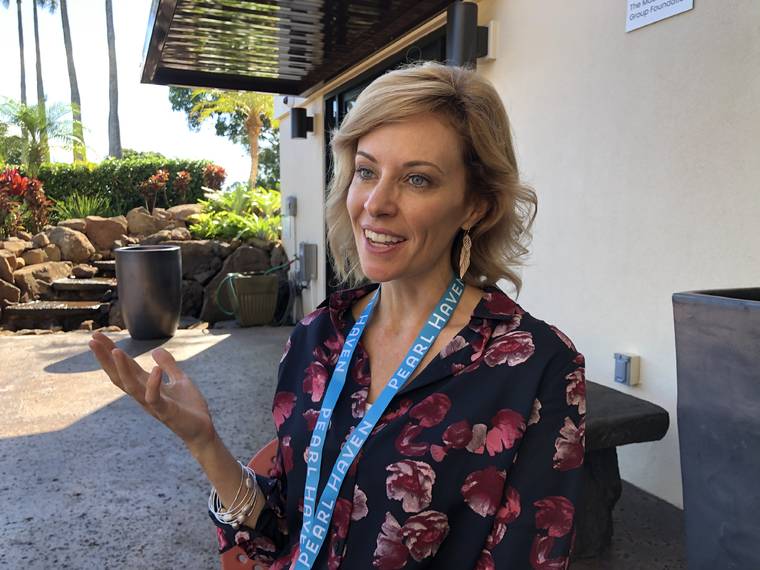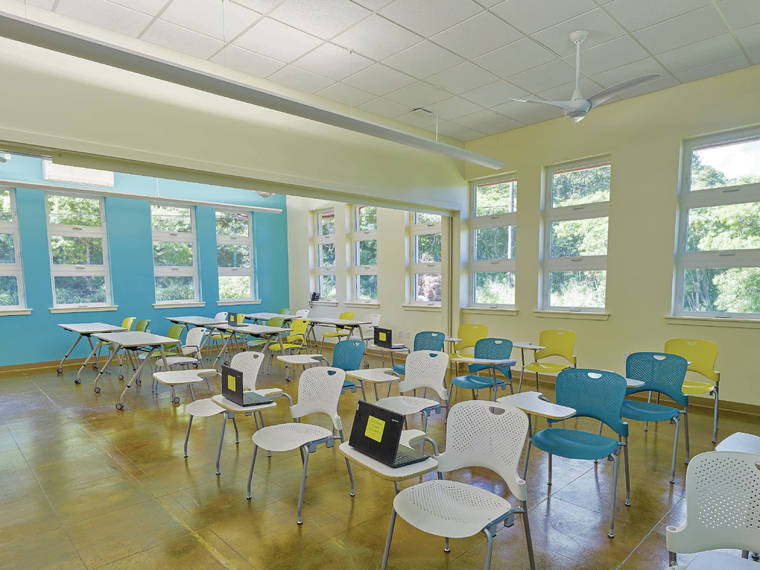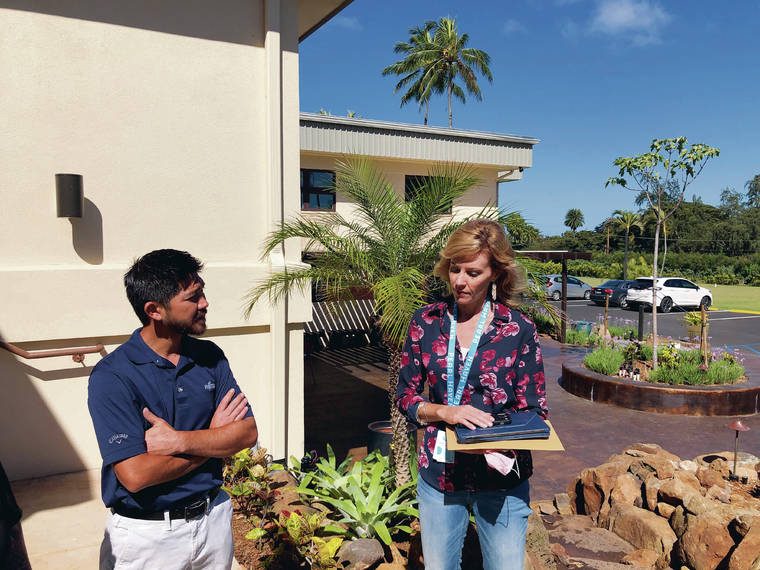Treatment facility opens for sexually exploited girls in Hawaii

COURTESY ANDREA BRIZZI, AHL
The Bromley Family Pearl Haven Campus began offering longterm therapeutic care and education to sexually exploited youths as of June 1.

SUSAN ESSOYAN / SESSOYAN@STARDVERTISER.COM
Nurse practitioner Jessica Munoz, president of Ho‘ola Na Pua, saw the need for a place like Pearl Haven more than a decade ago and rallied the community to make it happen.

COURTESY ANDREA BRIZZI, AHL
Youth will attend school at Pearl Haven while receiving long-term therapy to help them recover from abuse. This is one of two classrooms on campus.

SUSAN ESSOYAN / SESSOYAN@STARDVERTISER.COM
Jessica Munoz, president of Ho‘ola Na Pua, met with Glen Kozuma, director of sales and purchasing for Admor HVAC Products Inc., last month outside Pearl Haven.

COURTESY HO‘OLA NA PUA
The buildings that became Pearl Haven had stood empty for years and been vandalized. Construction started in the summer of 2018, even before all the funds were raised. Renovations continued straight through the pandemic until completion this spring.





The list of major donors goes on and on, stretching across a long wall inside Pearl Haven: more than 500 names of individuals, companies, charities and service groups.
It is testament to the potential the Hawaii community sees in the girls who come here for comprehensive care and healing, even if they may have lost hope for their own futures, robbed of their childhoods, their bodies sold for sex.
The first licensed, therapeutic residential facility in Hawaii designed to help sexually trafficked girls recover from their trauma opened June 1 without fanfare on a secluded, pastoral, 12-acre property on Oahu. Formally known as the Bromley Family Pearl Haven Campus, it welcomed its first few residents and intends to ramp up operations gradually to serve up to 32 youths.
“It’s been a journey,” said 38-year-old Jessica Munoz, a nurse practitioner who conceived of the project more than a decade ago and mobilized the community to make it happen. “When you’re pioneering anything, there are always unforeseens.”
“In our state, we haven’t had a program like this that’s specific to traumatized, sexually exploited girls,” she explained. “So what this program is going to offer is a safe place for wraparound healing services, education, therapy, family intervention therapy and lots of expressive arts.”
The journey to create a place of refuge and renewal dates back to when Munoz was working in the emergency room and encountered minors with troubling signs of potential sexual abuse. They came into the hospital accompanied by possible perpetrators, family members, law enforcement or social service workers.
Don't miss out on what's happening!
Stay in touch with breaking news, as it happens, conveniently in your email inbox. It's FREE!
“I just recognized that the stories were not always lining up,” said Munoz, who moved to Honolulu from California in 2006.
At that time, many people didn’t believe sexual trafficking of minors was a problem in the Aloha State, she said, and some blamed the girls themselves.
“Our system had often labeled these youth as runaways, delinquents, truants and substance users, and yet the core root of what was happening is they were being exploited,” she said. “Anyone can traffic and exploit children. It can be family, it can be someone deemed as a ‘friend,’ and it can also be an outside person.”
She began talking to people about the issue, reaching out to then-Family Court Judges Karen Radius and R. Mark Browning, leading advocates for youth who were aware of the gaps in services and had been working to expand holistic care.
Munoz teamed up with other volunteers to found the charitable nonprofit Ho‘ola Na Pua Opens in a new tab, which received tax exempt status in 2014. Its name means New Life for Our Children and its mission is to prevent sex trafficking and provide care for children who have been exploited.
“When I first started, this was a difficult conversation to have and people didn’t always want to hear about it,” Munoz said. “There was disbelief. Now because it’s much more seen in mainstream news and media, we are starting to realize the depth and scope of this issue.”
The nonprofit’s representatives visit schools to teach students and staff about risk factors for sexual exploitation, warning signs and how to get help. They work with youth in juvenile facilities and train professionals on the front lines. A mentoring program matches youth aged 11 to 24 at risk of exploitation with trusted adults to learn to build safe, healthy relationships. Ho‘ola Na Pua also operates a 24-hour help line.
By far its biggest project is the pristine Pearl Haven facility, which will provide intensive therapeutic care to girls ages 11 to 17 with suspected or confirmed sexual exploitation and severe emotional disturbance or complex post-traumatic stress disorder.
“Just as a piece of sand transforms gradually into a pearl, healing from sexual trauma requires layers of consistency, structure, safe, nurturing relationships, and corrective experiences,” the Pearl Haven brochure says.
The Honolulu Star-Advertiser agreed not to publish Pearl Haven’s location to protect the privacy and safety of youth treated there.
The 24,000-square-foot facility, surrounded by flowering plants, fruit trees and palms, is nestled away from distractions on a rural parcel far from Honolulu. Once-dilapidated buildings have been transformed to focus on comfort and healing, with living areas in a pastel palette, artwork, cozy dorm-style rooms, a meditation room and a movement studio for dance, yoga and hula.
The length of stay is based on clinical necessity, but research has shown that nine to 18 months is effective, Munoz said. The approach is holistic, offering psychotherapy, trauma recovery, health services, life skills development and relationship building. Girls will attend school in state-of-the-art classrooms on campus. A full commercial kitchen can also be used for teaching, and plans include agriculture, gardening and animal therapy.
“We believe that environment is a huge piece in a child’s ability to heal,” said Munoz, who is president of Ho‘ola Na Pua, which now has 12 full-time staff for its community-based programs. The staff for Pearl Haven now numbers 18, including coach-counselors and therapists.
Pearl Haven is licensed by the Department of Health as a special treatment facility, and girls may be referred by agencies, educators, families, social workers and medical providers. It is currently negotiating contracts with the state and private insurance companies.
“For years, we’ve been having to send youth to the mainland for residential treatment,” Munoz said. “Now we don’t have to do that because we have an option here. That’s important because children need to reintegrate back into their community.
“Our goal is to equip the youth as well as the family, whether it’s a biological family or a foster family, with the tools to continue to support these youth and help them to be successful,” she said.
Creating Pearl Haven was a daunting task, but major breakthroughs helped keep it on track. Jody Allione, a developer, was one of the first volunteers to join Munoz in her quest, and started off looking for a small, vacant parcel.
When they discovered the state was looking to lease this property, which had housed a nursing home, they saw its potential but feared it would be too costly. As it turned out, the nonprofit qualified for a nominal rate since it would provide a needed service that wasn’t available in the state. In 2014, Ho‘ola Na Pua secured a 40-year lease from the Department of Land and Natural Resources.
Then came a setback. In the eight months between securing the site and getting the right of entry in 2015, the property was completely vandalized – windows broken, graffiti sprayed all over and every item of value stolen.
“They took all the copper, all the fixtures, all the electrical wire,” Allione said. “They ripped all the guts out. … When we started, it was pretty cavernous and scary looking and pretty awful.”
The first grant, from the Harold K.L. Castle Foundation, went toward building a fence to secure the property and other development costs.
In 2015, Ho‘ola Na Pua also secured a $1 million grant from the state to begin renovating the property. While the “bones” of the building were solid, the interior was to become cleared out as a clean slate.
Allione vividly remembers analyzing the bids that came in from leading architecture firms. She checked for the bottom line on each, jotting down the figures. But she had trouble finding the price tag for the bid from Architects Hawaii Ltd.
Finally she saw the relevant sentence: “We propose to do this pro bono.”
“I almost fell out of my chair,” Allione recalled in an interview. “I called Jessica. I said I can’t believe this. They said they wanted to do this pro bono! I’ve got to make sure I’m not imagining things.”
Because it was such a large project, AHL teamed with another architecture firm, Design Partners Inc., as well Minatoishi Architects, Insynergy, and Kai Hawaii, Inc. Altogether the five firms donated more than $1 million in design and engineering services.
“That was the second big blessing,” Allione said. “The first was getting the site.”
The capital campaign, launched in 2016, aimed to raise $9 million for construction and renovation. Along with donors big and small, hundreds of volunteers have pitched in along the way, students took up collections, and service clubs donated their labor.
“We used a tangible building to show an invisible population and their needs,” Munoz said. “As we continued to renovate and work on the facility and show progress, I think people started to see that this was really going to happen.”
“Landmark Builders was the contracting company who did this project and they were phenomenal to work with,” she added. “We started renovation in the middle of 2018 and we didn’t stop one day until it was done, which was amazing since we started the project without all the funding raised. As we would get low on our funds, miraculously we would get another donation that kept us going.”
And then finally, in the midst of the coronavirus pandemic, at a time of great need across the state on so many fronts, came the biggest donation of all.
“An amazing woman, Lauran Bromley, who’s a big advocate for youth and girls and women, said, ‘I believe and I want to see this project finish,’” Munoz said.
The Bromley Foundation donated $2 million last July Opens in a new tab to help Pearl Haven reach its goal.
“Jessica and her team at Ho‘ola Na Pua have made remarkable strides against enormous adversity on the issue of trafficking,” Bromley said in announcing the gift. “The future safety of our children is a community’s responsibility.”
—
Child sex trafficking in Hawaii
Gauging the extent of child sex trafficking in Hawaii is challenging. The crime easily escapes detection and goes unreported, occurring behind closed doors with vulnerable minors unable to advocate for themselves.
The Department of Human Services received 246 unique reports of child sexual abuse and 82 of child sex trafficking in 2019, according to its latest annual report, “Child Abuse and Neglect in Hawaii Opens in a new tab.” The agency was able to confirm 92 of the sexual abuse cases and 15 of sex trafficking.
In 2020, 1,757 youth were reported as runaways across the state, according to the Department of the Attorney General. The National Center for Missing & Exploited Children Opens in a new tab says that 91% of the more than 29,000 children reported missing in the United States in 2019 were “endangered runaways,” and of those, one out of six were likely victims of sex trafficking Opens in a new tab.
“Sex Trafficking in Hawaii Opens in a new tab: The Stories of Survivors,” published in 2019, assessed the experiences of 22 female survivors of the sex trade. It was written by Dominique Roe-Sepowitz of the Arizona State University Office of Sex Trafficking Intervention and Khara Jabola-Carolus of the Hawaii State Commission on the Status of Women.
The researchers found that the age of the first sex trafficking experience for the group ranged from 11 to 20 years old, with an average age of 14.7 years. Nearly three quarters of those interviewed said they had experienced child sexual molestation. And 21 out of 22 said they had run away from home before age 18.
From April 1 through June 30, Pearl Haven received more than two dozen calls for placement of girls, according to Jessica Munoz, president of Ho‘ola Na Pua, which operates the facility that opened June 1 to provide comprehensive care for youth who have been sexually exploited.
—
Pearl Haven timeline
2009: Jessica Munoz encounters young victims of sex trafficking while working as a nurse practitioner in the emergency room.
2010-11: She envisions creating a safe, therapeutic haven for them.
2013-14: Ho‘ola Na Pua, a charitable nonprofit, is created with an all-volunteer team.
2014: Site identified and lease obtained from the state for 12-acre property with 24,000 square foot building. Harold K.L. Castle Foundation covers development costs.
2014-2019: Rotary, Soroptimists and multiple foundations and individuals provide grants and support to build Pearl Haven.
2015-17: North Shore Consultants donates time to secure land use and special permits. The Neighborhood Board votes unanimous support.
2015: State of Hawaii issues $1 million grant to start design and renovation.
2016: AHL and Design Partners Inc. take on the project at no charge.
2018: Groundbreaking and Hawaiian blessing.
2019-20: Donations of furniture, fixtures and equipment secured.
2020: Bromley Foundation gives $2 million to help complete first phase of capital campaign.
2021: The Bromley Family Pearl Haven Campus welcomes its first youth.
To learn more, visit hoolanapua.org Opens in a new tab.



